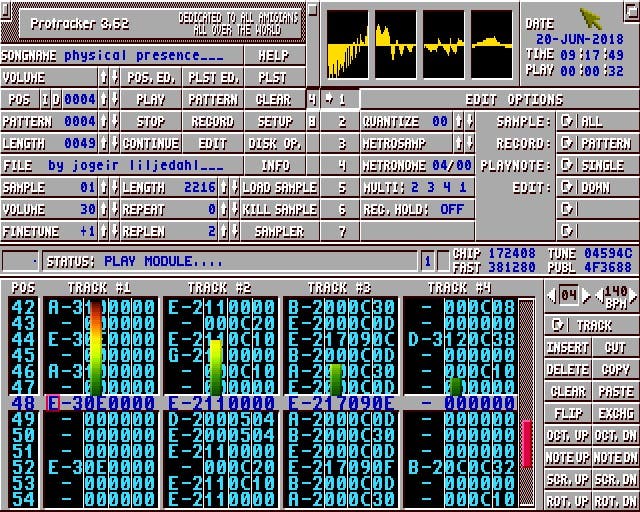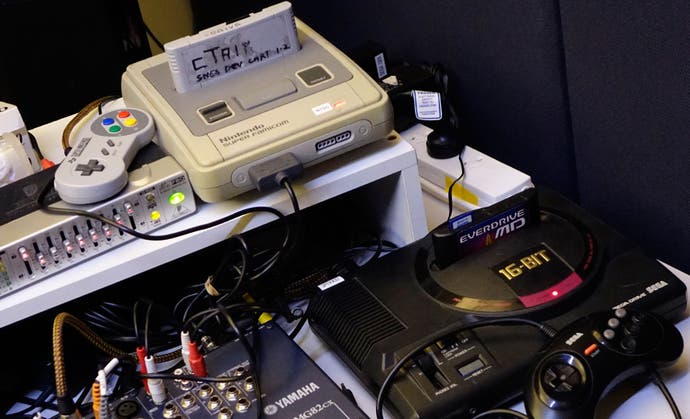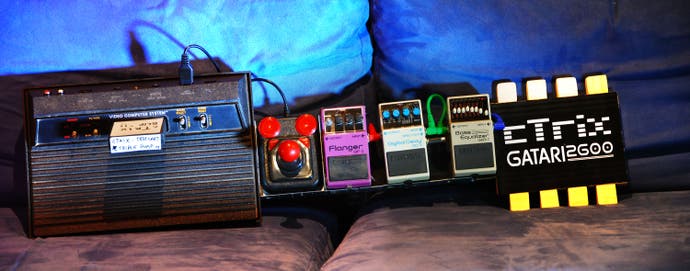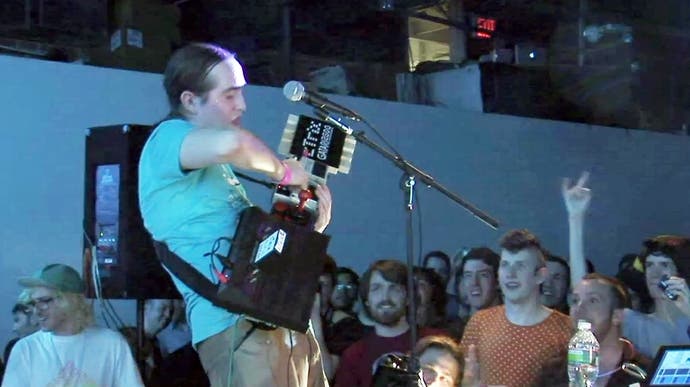Meet the people making music with Mega Drives, Game Boys and gAtaris
Game jam.
I've yet to meet a gamer who doesn't hold a special place in their heart for the hardware of yesteryear. Even those of us who gamed on PCs or Amigas love to wax lyrical about big boxes and trackball mice. Those formative experiences shape the adults we become, motivating us to walk the various paths we take through life. It won't surprise you to learn that Stephen King spent his childhood watching horror movies at his local theatre, or that Gary Gygax had a lot of love for pulp and high fantasy fiction, long before he got into wargaming
This very human trait is no less evident when someone's childhood is spent playing Sonic or Mario and while chiptunes, the affectionate nickname given to music that apes 8-bit and 16-bit sound chips, are certainly not a new thing, some of their proponents are taking the creation of new music on old hardware to interesting places.
Freezedream is the stage name of Australian composer and performer Nathan Stanley, who's live performances involve pairing up a couple of Sega Mega Drives and routing them through a piece of software called VGX Live. This allows him to create ROM files of the same variety that would be found on a standard Mega Drive cartridge. This software was built, in his own words, "by my genius coding friend Alex Cichowski", and it enables Stanley to manipulate the classic console's Yamaha sound chip, effectively turning it into a primitive synthesizer.
"I wanted to make my own sounds as far back as I can remember," explains Stanley, describing his childhood. "My family bought a secondhand Amiga 500 and later an Amiga 2000. On those computers I could create music with up to four instruments playing at the same time, using sound samples of anything from real instruments to synthesizers to vocals and sound effects." Indeed, the Amiga computers were something of an auditory revelation when they first came out, with a number of early industrial/hardore artists, such as EC8OR, using the Amiga 500 to generate all of their music.

Most importantly, however, the Amiga was the birthplace of the music tracker, a type of software that allowed users to place musical notes at certain points on a chronological line, often represented by a combination of letters, numbers and hexadecimal code. This was revolutionary for a number of reasons, but chief among them was composers could now create songs on a computer without any knowledge of programming. Many of your favourite video game soundtracks of the 16-bit era owe their very existence to this innovation and it's still the method of choice for composing music for old hardware.
For Stanley, the use of trackers and Mega Drives was as much an artistic decision as it was an academic realisation. While he describes the Mega Drive's sound as "just stunning, from mellow and melodic to harsh and robotic", Stanley also seems to have an almost religious respect for the physicality and tactility of using real hardware to generate audio on the fly. "It has an actual Yamaha synthesizer chip inside which means it generates the sounds instead of just playing back a recording of the instruments. I always wanted to own a hardware synthesizer but could never afford it, but I could afford a secondhand Mega Drive, which was pretty close!"
This desire to have the Mega Drive flex its muscles was something Stanley took to its logical conclusion when the physical release of his 2010 album, 'Today', came exclusively on a Mega Drive cartridge. For Stanley, this was all about playing with hardware. "I was enamoured with cartridges and realtime music. Just the physicality of a cartridge, it's a solid thing you can hold with a nice label and some circuitry inside. It's a beautiful thing by itself, but when you plug it into the console, magical things happen!" It's this desire, to have the Mega Drive be the musician, instrument and record player, that seems to drive Stanley towards what must be a significant amount of extra effort. During my conversation with him, he frequently remarks on the importance of how "the sounds are generated by the sound chip every time you listen" and the fact "it's not a recording".
Stanley has even composed for an actual Mega Drive game, Tanglewood, which came out in 2018. He personally sought out developer Matt Phillips and offered to do the game's soundtrack. "Composing for Tanglewood was a great new challenge," explains Stanley. "Matt would send me progress ROMs of each level and set the scene and atmosphere, or tell me about a boss battle and what type of feeling he was looking for."
The impression I get of Stanley is he's a turbo-nerd with a level of passion for both music and gaming that matches the extremes to which he'll go to achieve authenticity. I mean, we're talking about a guy who bought up a bunch of old Mega Drive carts and personally re-purposed them to host his album. His love for physical hardware is especially appealing to someone like myself, who spends far too much time (and money) trawling ebay for weird old video game tat no-one else in their right mind would spend money on.
One of Freezedream's contemporaries is Amercian composer Joshua Davis, better known by his stage name of Bit Shifter. His first album, Life's a Bit Shifter, was actually covered in Rolling Stone magazine, gaining the genre a degree of previously unheard of respect. It was, however, his 2006 EP, The Information Chase, that really showed off what can be achieved musically with a chunky old Game Boy.
Much like Freezedream, Davis was heavily influenced by a childhood full of gaming and guitars. "My first introduction to video games was a system my family had, which I believe was the APF TV Fun," he begins, "though my memory is hazy." He would soon graduate to an Atari 2600 and, later, an Intellivision. As a teenager he picked up a guitar, writing what he describes as "clumsy rock songs", thus cementing his lifelong passion for composition. During this adolescent phase, Davis would get into home recording on old four-track cassette recorders and MIDI hardware sequencing. He explains: "once digital audio recording and editing started to become a reality, it was great in a lot of ways, but somehow having the option of 16 or more audio tracks in software never quite held the same magic for me as working with four tracks on cassette." Davis speculates this probably has a lot to do with why the comparatively limited four channels of the Game Boy is so appealing to him. It's working with those constraints that makes it so much fun.
Such limitations bring a degree of accessibility and Davis is quick to point out how anyone can get involved with composing music on the Game Boy. "Ultimately, it's just a simple synthesizer," he insists. "Controlling that synthesizer is the hard part, but all you need is home-brew software like Little Sound DJ or Nanoloop." The software he's referring to was written specifically for the Game Boy by independent bedroom programmers and enthusiasts. It can be loaded onto rewritable Game Boy cartridges and fired up on the console itself, presenting an on-screen interface for creating music, not unlike the above image of the Amiga's Protracker. Davis continues: "the Game Boy's headphone jack provides a simple means of sending audio out to a recording device or sound system. Performance can take different forms; real-time manipulation, syncing multiple Game Boys via the Game Boy's GameLink port, syncing (or even controlling) the Game Boy with other audio hardware, and so forth."
Davis is a true ambassador for chiptunes. He genuinely wants more people to pick up old hardware and make music with it, even dedicating a large chunk of our conversation to tips and tricks for getting started. If Davis is the poster-boy for pick-up-and-play chiptune creation, our next interviewee is the perfect example of just how complicated you can make it.
cTrix is a musician based in Australia and the creator of the gAtari 2600, a kind of Frankenstein's monster imitation guitar, constructed from an old Atari 2600, a bunch of effects units, stomp boxes and painted wood. When he fires it up, the experience is like being locked in a metal box while angry people chuck Donkey Kong cartridges at you. It looks complicated, unwieldy and impractical, but most of all, awesome! While the gAtari (I'll never get tired of typing that) is his most famous invention, cTrix will, if given the opportunity, compose music with pretty much any bit of old gaming gear he can lay his mitts on. He's worked with the SNES, Mega Drive, Vectrex, Commodore 64, Amiga and a whole bunch of other stuff.
This eclectic repertoire is, once again, a direct result of his upbringing. Both of cTrix's parents programmed punch card computers and so, in an era when most of his mates were playing on Master Systems and Nintendos, little cTrix junior played with a Commodore 64, a computer renowned for its impressive sound chip. At the age of six, the Commodore 64's BASIC screen didn't mean much to him, but the computer magazines lying around his home had a few commands that forced the machine's SID chip to make various beeps and noise blasts. Inspired by his success, it wasn't long before he acquired a piece of software called 'The Music Composer' and although not quite tall enough to brush his teeth in the sink, cTrix now owned his first synthesizer.

In the early '00s, a friend of cTrix's was getting rid of some attic junk and gifted him an old Atari 2600. Within weeks it became the official drunk gaming machine at his house. "We'd drink beer and play multiplayer Freeway, Frogger or something terrible like Fishing Derby for an entire night," he explains. "I had huge speakers for my TV and could hear some seriously big bass on a few of the Atari sound effects. We used to crank the bass and I'm pretty sure we were the only household in 2005 who had the police knocking on the door with noise complaints from an Atari 2600!" It was this experience that inspired cTrix to turn his Atari into a gAtari. "It had two channels, tons of banging bass, noise for drums and some old-school square waves" he recalls.
"That was enough for a dance floor for me!"
Forcing an Atari to generate beats and bass with its mighty 4kb of ROM is all good and well, but those limitations pose a problem when composing. All of cTrix's creations ended up being quite repetitive, so he began to route the Atari's audio output through various effects units, allowing him to manipulate the sound externally. "I plugged in my stomp-box EQ and it sounded massive. I also added an old delay pedal to warp the sound and loop the last track so I could blend stuff together. By the time I added a joystick for jumping between parts of the song, I now had more bits of gear than everything else on stage put together!" cTrix's solution to this cumbersome issue was obvious. "I went to my mate's house with some planks of wood and we bolted the whole thing together in an afternoon, then we laughed our heads off." He chuckles, before adding: "I hadn't even finished a single tune at that point!"
cTrix unveiled the gAtari at Blip Festival NYC in 2011, during his live show. "I kept the whole thing a huge surprise until halfway through my set when I pulled out the gAtari with a huge grin. People cheered, I strapped myself in, powered on, selected the first track, hit go and... it didn't work. To begin with there was buzzing, then just distorted, unrecognisable sound."

Standing in front of the audience, cTrix was experiencing every live performer's worst nightmare. "You can hear my voice panic in the recording," he admits. "It was the worst thing ever. Years of work, giving up, starting again, pushing though so many obstacles, and my stupid gAtari was dead, live on stage, mid-set, with me standing there like a moron as the last act of the night, supposedly bringing the roof down."
After the longest 90 seconds of his life, spent mostly scrambling about, unplugging and replugging things, cTrix hears the heroic sound guy yell "try again" and boom! The faulty sound box on the stage's floor had been replaced and all was well. "I was still shaking from the fail and not quite sure if it was going to die again," he recalls. But it didn't die and if the recording is anything to go by, the audience went crazy (although cTrix says he can barely remember it, being full of adrenaline and all). By the end of the show, half the audience had stormed the stage (common chiptune shenanigans) during the encore and, in his own words, cTrix "played Amiga rave bangers until we danced on the DI boxes and snapped a cable".
cTrix would go on to take his gAtari all over the world and has performed with it in South America, the UK, Germany, the Netherlands, New Zealand, Hungary and back home in Australia. Ultimately, for him, much like the other interviewees in this article, it's all about the challenge created by the hardware's limitations. "I just find the old-school tracker-style of making tunes to be incredibly fun," he explains. "Making full-sounding music with just a few audio channels is the ultimate puzzle game."
He also shares the same kind of respect for the original hardware that his contemporaries have. "My view is that if a track is written for a Sega Mega Drive, then it should be played from a Sega Mega Drive," he asserts. "Sure, emulation can create a crystal clean and noiseless sound, but having the hardware just adds that bit of authenticity. Plus, with some of the tracks pushing the limits of the hardware, I want people to know that it will actually play on that hardware."
Throughout my conversations with these guys, the thing I find most endearing is how transformative their work is. These musicians have taken lumps of plastic and wiring that were designed to play video games and turned them into something completely different. In a sense, they're continuing the very tradition that bore the games industry in the '50s and '60s. Those early computer programmers who developed primitive games by messing around with cathode ray tubes, or by forcing text outputs to tell an interactive story, were also repurposing hardware to perform a new task.
Any of us can do it. You don't need any musical ability to mess around with a tracker and if you've got an old Game Boy or Mega Drive lying around in the attic, you've also got a synthesizer just waiting to be experimented with. If you want to have a go right now, then Famitracker will let you compose songs for the NES and it'll run on a Windows-operated potato. Give it a go, you never know, you might end up performing at your local chip festival!



